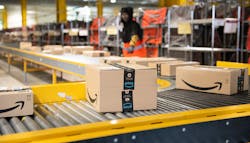Looking beyond pandemic reinforces steady prep and delivery processes
During the last two-plus years, the COVID-19 pandemic certainly took its toll on the global supply chain and all of the individual supply chains within the healthcare industry – from hospitals to nonacute care facilities, including ambulatory surgery centers, clinics and physician offices, retail and urgent care outlets, as well as imaging centers, mobile surgical suites and ultimately, the patient’s home.
As the pandemic squeezed and choked supply lines, increasing demand pressures on bulk deliveries to centralized locations, it also over-heated demand expectations outside of the hospital walls and within the nonacute community with smaller delivery points and lower units of measure.
Amazon Business knows a thing or two about making smaller deliveries more frequently to a vast number of delivery points. Sandhya Dhir, Head of Healthcare Strategy and Development, Amazon Business, shares her company’s philosophy and thoughts on weathering pandemic-related pent-up demand.
HPN: As you look at the distribution, inventory and logistics product and service opportunities beyond the hospital that have emerged during the pandemic, what stands out as the most noteworthy and why?
At Amazon Business, nonacute organizations can enable employees to quickly source millions of high-quality products and access business-only pricing while leveraging our analytics tools that provide greater visibility into spend. By consolidating access to multiple suppliers, we minimize inherent risk associated with directly purchasing from multiple individual suppliers, the staff time spent onboarding and managing vendors, and the labor-intensive manual approval process to actually allow staff to place these orders. In addition, Amazon Business provides both bulk and parcel capabilities and can enable multiple ship to addresses, allowing organizations to maintain optimal operations in the set up and workflow approval that works for their unique structure. As organizations simplify sourcing and scale digital solutions to gain clarity on spend across the organization, supply chains become more efficient, reliance on contract administration is reduced, and the benefits of e-commerce tools are realized.
What are some of the key challenges that mainline distributors, specialty product distributors, third-party logistics companies and/or DME suppliers must address to succeed within “the new nominal” or even “the new tolerable” (as opposed to “the new normal”)?
Addressing the new tolerable is broad, but a key component is how do supply partners address and improve the historic “just in time” model while balancing space and cash flow constraints. By focusing on new technologies and new supply chain models, providers are able to build more resiliency. While some of the shortcomings of the JIT model was exposed during the pandemic, managing backorders and stock-outs has always been a concern for all providers, specially outside the hospital, to the point that industry almost turned their back on recognizing this is a problem that can have better solutions. A way to create a balance and still be able to rely on a JIT model is to ensure an organization is already set up to access multiple sources of supply as soon as fluctuations, especially when not predictable, occur. In addition, leveraging newer e-commerce technologies including ERP API integrations, approval workflows, auto-reorder tools, and real time analytics builds efficiencies during times of supply uncertainty.
With pandemic protocols ushering more of healthcare not clinically determined to the critical, emergent, serious or triage-worthy to facilities outside of the hospital setting and theoretically away from the “protective management oversight” of hospital operations – most notably the patient’s home via telemedicine – what financial and operational challenges do you see emerging from this? How does the hospital-based Supply Chain team handle the expanded responsibilities and expect suppliers to help? How does the supplier team advise and help the provider customers – either through processes or products? Will you provide examples?
At Amazon we innovate on behalf of our customers, creating a hands-off experience so organizations have the supply they need, in the right specifications and quantity, without overly complicated management. While Amazon continues to improve our bulk capabilities, we see opportunities for organization to do less bulk ordering, given the inflexibility and costs to manage, and transition to smaller orders that gets shipped directly to the end user, wherever they are. Combining our parcel delivery strengths with Amazon’s world class fulfillment network, organization are finding they can create efficiency and costs savings by bypassing intermediaries and eliminating multiple steps to get supplies directly and quickly to the final user. This model reduces cash tied up in inventory and improves operations by having fewer personnel assigned to managing and breaking down bulk deliveries. Creating future distribution models are something we obsess over on behalf of our customers at Amazon!






